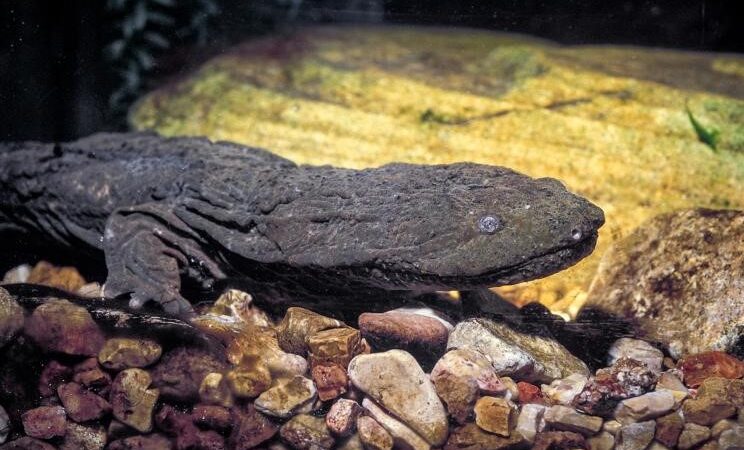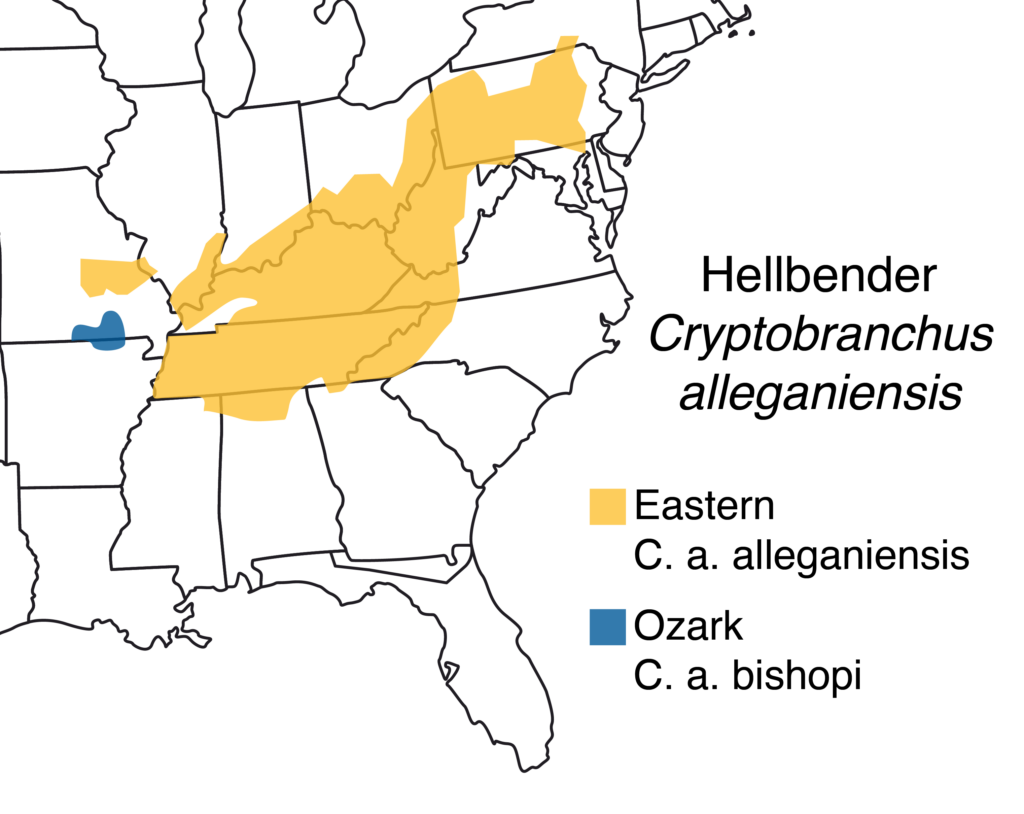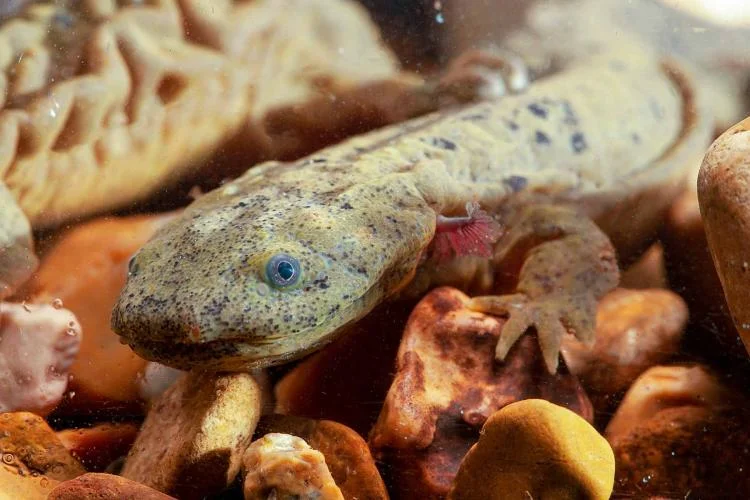Creature Feature: Hellbenders

Published April 17, 2024
In pristine rivers and streams, where habitats thrive to create a heavenly oasis, dwells an amphibian with a sinister name – the North American hellbender. Despite their intimidating name, these aquatic salamanders are very shy and harmless. Their name is thought to have come from people believing they were creatures determined – or “bent” – on returning from the underworld – hence the name “hellbenders”.
They are the largest salamander in North America, reaching lengths between 11-23 inches – some much longer – and they have wide, flat heads which make crawling under large rocks and into crevices an easy task. Hellbenders have tiny eyes and a broad rudderlike tail; despite having a tail, they hardly swim and get around primarily by walking along riverbeds at night since they are nocturnal.
There are two subspecies of hellbenders: the Ozark hellbender and the eastern hellbender. The eastern hellbender is found in a different geography than the Ozark hellbender, with a range extending from southwestern New York to northern Alabama and extreme northeastern Mississippi. The Ozark hellbender is restricted to southern Missouri and northeastern Arkansas. Missouri is unique as it is the only state where both subspecies of hellbenders reside!

Both the Ozark and eastern hellbender prey on crayfish and play an important role in maintaining their populations. If crayfish populations explode in streams and rivers, it can lead to a reduction or elimination of aquatic plant beds. Plant beds serve as spawning and nesting sites for game fish such as bass and sunfish and are also habitats for insects and smaller fish that are food for game fish.
Both subspecies have been facing a rapid population decline and were flagged as endangered by Missouri in 2003. In 2011, the Ozark hellbender was declared federally endangered by the U.S. Fish and Wildlife Service, followed by the eastern hellbender in 2021. Because hellbenders thrive in clean, clear, cool water, their primary threat is habitat alteration and degraded water quality due to pollution. Over-collecting, diseases like amphibian chytrid fungus, and predation are other threats these amphibians face.
Hellbenders are natural indicators of the overall health of rivers and streams. Today, they exist in the few waterways where unpolluted water flows. They are extremely sensitive to water changes. Rarely ever using their lungs, they breathe by absorbing oxygen through the folds across their body. If chemicals or other contaminants seep into healthy rivers and streams where hellbenders dwell, the chemicals can be absorbed into their skin, disrupting the animals’ natural physiological processes causing them to suffocate.

Keeping rivers and streams as clean as possible can help hellbenders – and other animal and plant species – remain a part of our freshwater ecosystems. Missouri has several waterway cleanup efforts such as Missouri River Relief made up of hundreds of volunteers whose mission is to remove trash from banks, forests, and floodplains off the Missouri River. Missouri Stream Team is another project made up of volunteers dedicated to education, stewardship, and advocacy regarding Missouri’s waterways. Missouri residents are encouraged to partner together to establish their own team to help support the mission of river conservation.
Along with ongoing habitat efforts, the St. Louis Zoo has bred and released hellbenders into the wild to help ensure the longevity of this species. In 2022, their 10,000th hellbender was bred in human care and then released into an Ozark river – making it a significant achievement for the future of these unique amphibians.
Ensuring our rivers and streams have high-quality water is essential to conservation and helping to maintain wildlife species. Without these and many other initiatives, waterways across the nation would decline rapidly. You can celebrate Earth Day this year, on Monday, April 22nd, and help aquatic species like hellbenders by cleaning up plastic in rivers, streams, ponds, and lakes nearby. These species can also be supported by refraining from using pesticides or other harmful chemicals in gardens that can runoff into waterways. See how you can get involved with local cleanup efforts by joining groups like Missouri River Relief or a local Missouri Stream Team. You can also challenge yourself to pick up as much trash as you can find while outdoors. Whatever you decide, make it fun, get creative, and don’t forget – stay green & keep the water clean!
Wonders of Wildlife is home to a few Ozark hellbenders who can be found in the River and Streams exhibit. They are excellent at hide-and-seek, so if their exhibit looks empty, it’s not – they just like to show off their hiding skills! The museum and aquarium will also have Curiosity Crates in various exhibits where you can learn more about wildlife and how you can take part in conservation efforts, on Earth Day, and every day!
Join the Wonders of Wildlife Community and subscribe to our newsletter for upcoming events, promotions, and conservation stories by clicking HERE.
News & Updates
Read the latest news & updates about Wonders of Wildlife.
Recent News & Stories
- Behind the Scenes: Highlighting Our Keepers’ Hard Work
- Shark & Ray Awareness Day: Heroes of the Sea
- Seven “JAWS”ome Souvenirs to Celebrate Shark Week!
- The Largemouth Bass – America’s Most Beloved Fish
- Cities of the Ocean: The Importance of Protecting Coral Reefs
- Turtle Treks: WOW’s Sea Turtle Center Continues Contribution to Conservation
- Back to Los Llanos: Restoring the Orinoco Crocodile
